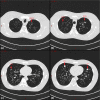Evaluate the performance of four artificial intelligence-aided diagnostic systems in identifying and measuring four types of pulmonary nodules
- PMID: 33369008
- PMCID: PMC7856495
- DOI: 10.1002/acm2.13142
Evaluate the performance of four artificial intelligence-aided diagnostic systems in identifying and measuring four types of pulmonary nodules
Abstract
Purpose: This study aims to evaluate the performance of four artificial intelligence-aided diagnostic systems in identifying and measuring four types of pulmonary nodules.
Methods: Four types of nodules were implanted in a commercial lung phantom. The phantom was scanned with multislice spiral computed tomography, after which four systems (A, B, C, D) were used to identify the nodules and measure their volumes.
Results: The relative volume error (RVE) of system A was the lowest for all nodules, except for small ground glass nodules (SGGNs). System C had the smallest RVE for SGGNs, -0.13 (-0.56, 0.00). In the Bland-Altman test, only systems A and C passed the consistency test, P = 0.40. In terms of precision, the miss rate (MR) of system C was 0.00% for small solid nodules (SSNs), ground glass nodules (GGNs), and solid nodules (SNs) but 4.17% for SGGNs. The comparable system D MRs for SGGNs, SSNs, and GGNs were 71.30%, 25.93%, and 47.22%, respectively, the highest among all the systems. Receiver operating characteristic curve analysis indicated that system A had the best performance in recognizing SSNs and GGNs, with areas under the curve of 0.91 and 0.68. System C had the best performance for SGGNs (AUC = 0.91).
Conclusion: Among four types nodules, SGGNs are the most difficult to recognize, indicating the need to improve higher accuracy and precision of artificial systems. System A most accurately measured nodule volume. System C was most precise in recognizing all four types of nodules, especially SGGN.
Keywords: artificial intelligence; lung phantom; pulmonary nodules.
© 2020 The Authors. Journal of Applied Clinical Medical Physics published by Wiley Periodicals, Inc. on behalf of American Association of Physicists in Medicine.
Conflict of interest statement
The authors declare they have no competing interests.
Figures





Similar articles
-
"Will I change nodule management recommendations if I change my CAD system?"-impact of volumetric deviation between different CAD systems on lesion management.Eur Radiol. 2023 Aug;33(8):5568-5577. doi: 10.1007/s00330-023-09525-z. Epub 2023 Mar 10. Eur Radiol. 2023. PMID: 36894752 Free PMC article.
-
Persistent pulmonary subsolid nodules with solid portions of 5 mm or smaller: Their natural course and predictors of interval growth.Eur Radiol. 2016 Jun;26(6):1529-37. doi: 10.1007/s00330-015-4017-4. Epub 2015 Sep 18. Eur Radiol. 2016. PMID: 26385803
-
Influence of CT effective dose and convolution kernel on the detection of pulmonary nodules in different artificial intelligence software systems: A phantom study.Eur J Radiol. 2020 May;126:108928. doi: 10.1016/j.ejrad.2020.108928. Epub 2020 Mar 2. Eur J Radiol. 2020. PMID: 32146346
-
Subsolid pulmonary nodules: imaging evaluation and strategic management.Curr Opin Pulm Med. 2012 Jul;18(4):304-12. doi: 10.1097/MCP.0b013e328354a5f2. Curr Opin Pulm Med. 2012. PMID: 22575798 Review.
-
The Added Value of Computer-aided Detection of Small Pulmonary Nodules and Missed Lung Cancers.J Thorac Imaging. 2018 Nov;33(6):390-395. doi: 10.1097/RTI.0000000000000362. J Thorac Imaging. 2018. PMID: 30239461 Review.
Cited by
-
Software with artificial intelligence-derived algorithms for detecting and analysing lung nodules in CT scans: systematic review and economic evaluation.Health Technol Assess. 2025 May;29(14):1-234. doi: 10.3310/JYTW8921. Health Technol Assess. 2025. PMID: 40380885 Free PMC article.
References
-
- Finley RJ, Mayo JR, Grant K, et al Preoperative computed tomography‐guided microcoil localization of small peripheral pulmonary nodules: a prospective randomized controlled trial. J Thorac Cardiovasc Surg. 2015;149:26–32. - PubMed
-
- Kim EY, Bista AB, Kim T et al The advantage of digital tomosynthesis for pulmonary nodule detection concerning influence of nodule location and size: a phantom study. Clin Radiol. 2017;72:796.e1–796.e8. - PubMed
-
- Wang Y, Fu LC. The new research of artificial intelligent methods in medical image processing. Chin J Medical Physics. 2013;30:4138–4143.
-
- Wang X. Advances in artificial intelligence in medical imaging: feelings from RSNA conference in 2017. Radiol Practice. 2018;101–103.
MeSH terms
LinkOut - more resources
Full Text Sources
Medical

